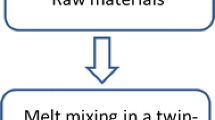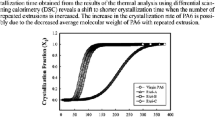Abstract
This work was aimed at understanding the influence of fibrillar morphology on melt viscoelastic properties of polymer blends containing various blend ratios (polypropylene/polytrimethylene terephthalate: 99/1, 94/6, 90/10, 80/20). The blends were processed on co-rotating twin-screw extruder, and fiber spinning was employed as a post-processing method. Scanning electron microscopy was used to analyze the interior morphology of the as-extruded samples and fibers, and it was revealed that droplet and fibrillar morphologies are the formed morphologies in as-extruded and fiber samples, respectively. To appraise the melt viscoelastic responses of samples, rheological measurements were conducted in both linear and nonlinear regions. Formed physical fibrillar network caused the storage modulus and complex viscosity to appear as a secondary plateau along with intensified values in low-frequency region compared with the as-extruded blend samples. Moreover, the fibrillar structure increased the elasticity of the fibers whose effect was monitored by increased values of transient stress responses and creep-recovery experiments.








Similar content being viewed by others
References
Friedrich K, Fakirov S, Zhang Z (2005) Polymer composites. Springer, Boston
Cassagnau P, Michel A (2001) New morphologies in immiscible polymer blends generated by a dynamic quenching process. Polymer 42(7):3139–3152. https://doi.org/10.1016/S0032-3861(00)00602-9
Utracki LA, Shi ZH (1992) Development of polymer blend morphology during compounding in a twin-screw extruder. Part I: droplet dispersion and coalescence—a review. Polym Eng Sci 32(24):1824–1833. https://doi.org/10.1002/pen.760322405
Shen J, Wang M, Li J et al (2011) In situ fibrillation of polyamide 6 in isotactic polypropylene occurring in the laminating-multiplying die. Polym Adv Technol 22(2):237–245. https://doi.org/10.1002/pat.1525
Hong JS, Kim JL, Ahn KH et al (2005) Morphology development of PBT/PE blends during extrusion and its reflection on the rheological properties. J Appl Polym Sci 97(4):1702–1709. https://doi.org/10.1002/app.21695
Bhattacharyya D, Fakirov S (eds) (2012) Synthetic polymer-polymer composites. Hanser, München
Fakirov S (2013) Nano-/microfibrillar polymer–polymer and single polymer composites: the converting instead of adding concept. Compos Sci Technol 89:211–225. https://doi.org/10.1016/j.compscitech.2013.10.007
Friedrich K (2005) Microfibrillar reinforced composites from PET/PP blends: processing, morphology and mechanical properties. Compos Sci Technol 65(1):107–116. https://doi.org/10.1016/j.compscitech.2004.06.008
Marcinčin A, Körmendy E, Hricová M et al (2006) Rheological behavior of polyester blend and mechanical properties of the polypropylene–polyester blend fibers. J Appl Polym Sci 102(5):4222–4227. https://doi.org/10.1002/app.24682
Shields RJ, Bhattacharyya D, Fakirov S (2007) Microfibril-reinforced composites from PE/PET blends: effect of reinforcement size on oxygen permeability. KEM 334–335:249–252. https://doi.org/10.4028/www.scientific.net/KEM.334-335.249
Lee SY, Kim SC (1997) Laminar morphology development and oxygen permeability of LDPE/EVOH blends. Polym Eng Sci 37(2):463–475. https://doi.org/10.1002/pen.11690
Monticciolo A, Cassagnau P, Michel A (1998) Fibrillar morphology development of PE/PBT blends: rheology and solvent permeability. Polym Eng Sci 38(11):1882–1889. https://doi.org/10.1002/pen.10358
Fakirov S, Kamo H, Evstatiev M et al (2004) Microfibrillar reinforced composites from PET/LDPE blends: morphology and mechanical properties. J Macromol Sci Part B 43(4):775–789. https://doi.org/10.1081/MB-120030024
Marcinčin A, Hricová M, Aneja A et al (2006) Polypropylene/poly (trimethylene terephthalate)–blend fibers. J Macromol Sci Part B 45(5):945–956. https://doi.org/10.1080/00222340600796223
Habibolah Zargar MR, Shoushtari AM (2019) Fabrication of polypropylene/poly (trimethylene terephthalate) blend fibers with highly improved resiliency and preserved mechanical properties. J Macromol Sci Part B 58(1):141–160. https://doi.org/10.1080/00222348.2018.1558576
Jayanarayanan K, Thomas S, Joseph K (2008) Morphology, static and dynamic mechanical properties of in situ microfibrillar composites based on polypropylene/poly (ethylene terephthalate) blends. Compos A Appl Sci Manuf 39(2):164–175. https://doi.org/10.1016/j.compositesa.2007.11.008
Jayanarayanan K, Ravichandran A, Rajendran D et al (2010) Morphology and mechanical properties of normal blends and in-situ microfibrillar composites from low-density polyethylene and poly(ethylene terephthalate). Polym Plast Technol Eng 49(5):442–448. https://doi.org/10.1080/03602550903414043
Jayanarayanan K, Thomas S, Joseph K (2009) Dynamic mechanical analysis of in situ microfibrillar composites based on PP and PET. Polym Plast Technol Eng 48(4):455–463. https://doi.org/10.1080/03602550902727874
Jayanarayanan K, Thomas S, Joseph K (2011) In situ microfibrillar blends and composites of polypropylene and poly (ethylene terephthalate): morphology and thermal properties. J Polym Res 18(1):1–11. https://doi.org/10.1007/s10965-009-9384-6
Jayanarayanan K, Thomas S, Joseph K (2012) Effect of blend ratio on the mechanical and sorption behaviour of polymer–polymer microfibrillar composites from low-density polyethylene and polyethylene terephthalate. J Reinf Plast Compos 31(8):549–562. https://doi.org/10.1177/0731684412440602
Jayanarayanan K, Thomas S, Joseph K (2016) Effect of blend ratio on the dynamic mechanical and thermal degradation behavior of polymer–polymer composites from low density polyethylene and polyethylene terephthalate. Iran Polym J 25(4):373–384. https://doi.org/10.1007/s13726-016-0429-5
Rizvi A, Andalib ZKM, Park CB (2017) Fiber-spun polypropylene/polyethylene terephthalate microfibrillar composites with enhanced tensile and rheological properties and foaming ability. Polymer 110:139–148. https://doi.org/10.1016/j.polymer.2016.12.054
Rizvi A, Park CB, Favis BD (2015) Tuning viscoelastic and crystallization properties of polypropylene containing in-situ generated high aspect ratio polyethylene terephthalate fibrils. Polymer 68:83–91. https://doi.org/10.1016/j.polymer.2015.04.081
Kakroodi AR, Kazemi Y, Ding W et al (2015) Poly(lactic acid)-based in situ microfibrillar composites with enhanced crystallization kinetics, mechanical properties, rheological behavior, and foaming ability. Biomacromolecules 16(12):3925–3935. https://doi.org/10.1021/acs.biomac.5b01253
Hajiraissi R, Jahani Y, Hallmann T (2018) Investigation of rheology and morphology to follow physical fibrillar network evolution through fiber spinning of PP/PA6 blend fiber. Polym Eng Sci 58(8):1251–1260. https://doi.org/10.1002/pen.24686
Huang Y, He Y, Ding W et al (2017) Improved viscoelastic, thermal, and mechanical properties of in situ microfibrillar polypropylene/polyamide 6,6 composites via direct extrusion using a triple-screw extruder. RSC Adv 7(9):5030–5038. https://doi.org/10.1039/C6RA26734C
Huang Y, He Y, Wang Y et al (2018) Studying the formation mechanism of in situ poly(butylene terephthalate) microfibrils prepared by one-step direct extrusion via orthogonal experimental design. Polym Eng Sci 58(7):1166–1173. https://doi.org/10.1002/pen.24678
Li X, Xin C, Huang Y et al (2018) Effect of dispersed phase on the morphology of in situ microfibrils and the viscoelastic properties of its composite via direct extrusion. J Appl Polym Sci 135(21):46286. https://doi.org/10.1002/app.46286
Rizvi A, Tabatabaei A, Barzegari MR et al (2013) In situ fibrillation of CO2-philic polymers: sustainable route to polymer foams in a continuous process. Polymer 54(17):4645–4652. https://doi.org/10.1016/j.polymer.2013.06.023
Xing Q, Zhu M, Wang Y et al (2005) In situ gradient nano-scale fibril formation during polypropylene (PP)/polystyrene (PS) composite fine fiber processing. Polymer 46(14):5406–5416. https://doi.org/10.1016/j.polymer.2005.03.100
Rizvi A, Park CB (2014) Dispersed polypropylene fibrils improve the foaming ability of a polyethylene matrix. Polymer 55(16):4199–4205. https://doi.org/10.1016/j.polymer.2014.06.014
Hajiraissi R, Jahani Y (2018) Non-terminal behavior as a finger print to follow droplet deformation. Adv Polym Technol 37(5):1517–1525. https://doi.org/10.1002/adv.21810
Jurczuk K, Galeski A, Piorkowska E (2014) Strain hardening of molten thermoplastic polymers reinforced with poly(tetrafluoroethylene) nanofibers. J Rheol 58(3):589–605. https://doi.org/10.1122/1.4867389
Seemork J, Sako T, Bin Md Ali MA et al (2017) Rheological response under nonisothermal stretching for immiscible blends of isotactic polypropylene and acrylate polymer. J Rheol 61(1):1–11. https://doi.org/10.1122/1.4965843
Yamaguchi M, Fukuda K, Yokohara T et al (2012) Modification of rheological properties under elongational flow by addition of polymeric fine fibers. Macromol Mater Eng 297(7):654–658. https://doi.org/10.1002/mame.201100270
Yokohara T, Nobukawa S, Yamaguchi M (2011) Rheological properties of polymer composites with flexible fine fibers. J Rheol 55(6):1205–1218. https://doi.org/10.1122/1.3626414
Hong JS, Ahn KH, Lee SJ (2005) Strain hardening behavior of polymer blends with fibril morphology. Rheol Acta 45(2):202–208. https://doi.org/10.1007/s00397-005-0015-9
Yamaguchi M, Yokohara T, Bin Md Ali MA (2013) Effect of flexible fibers on rheological properties of poly(lactic acid) composites under elongational flow. Nihon Reoroji Gakkaishi 41(3):129–135. https://doi.org/10.1678/rheology.41.129
Fakirov S, Bhattacharyya D, Lin RJT et al (2007) Contribution of coalescence to microfibril formation in polymer blends during cold drawing. J Macromol Sci Part B 46(1):183–194. https://doi.org/10.1080/00222340601044375
Folkes MJ, Hope PS (1993) Polymer blends and alloys. Springer, Dordrecht
Taylor GI (1932) The viscosity of a fluid containing small drops of another fluid. Proc R Soc A Math Phys Eng Sci 138(834):41–48. https://doi.org/10.1098/rspa.1932.0169
Taylor GI (1934) The formation of emulsions in definable fields of flow. Proc R Soc A Math Phys Eng Sci 146(858):501–523. https://doi.org/10.1098/rspa.1934.0169
Graebling D, Muller R (1990) Rheological behavior of polydimethylsiloxane/polyoxyethylene blends in the melt. Emulsion model of two viscoelastic liquids. J Rheol 34(2):193–205. https://doi.org/10.1122/1.550123
Supaphol P, Dangseeyun N, Thanomkiat P et al (2004) Thermal, crystallization, mechanical, and rheological characteristics of poly(trimethylene terephthalate)/poly(ethylene terephthalate) blends. J Polym Sci B Polym Phys 42(4):676–686. https://doi.org/10.1002/polb.10767
Khonakdar HA, Saen P, Nodehi A et al (2013) On rheology-morphology correlation of polypropylene/poly(trimethylene terephthalate) blend nanocomposites. J Appl Polym Sci 127(2):1054–1060. https://doi.org/10.1002/APP.37776
Dangseeyun N, Supaphol P, Nithitanakul M (2004) Thermal, crystallization, and rheological characteristics of poly(trimethylene terephthalate)/poly(butylene terephthalate) blends. Polym Test 23(2):187–194. https://doi.org/10.1016/S0142-9418(03)00079-5
Utracki LA (1991) On the viscosity-concentration dependence of immiscible polymer blends. J Rheol 35(8):1615–1637. https://doi.org/10.1122/1.550248
Grizzuti N, Buonocore G, Iorio G (2000) Viscous behavior and mixing rules for an immiscible model polymer blend. J Rheol 44(1):149–164. https://doi.org/10.1122/1.551073
Utracki LA, Kanial MR (1982) Melt rheology of polymer blends. Polym Eng Sci 22(2):96–114. https://doi.org/10.1002/pen.760220211
Xu H-S, Li Z-M, Pan J-L et al (2004) Morphology and rheological behaviors of polycarbonate/high density polyethylene in situ microfibrillar blends. Macromol Mater Eng 289(12):1087–1095. https://doi.org/10.1002/mame.200400197
Wu D, Zhang Y, Wu L et al (2008) Viscoelastic properties of polyarylene ether nitriles/thermotropic liquid crystalline polymer blend. J Appl Polym Sci 108(3):1934–1941. https://doi.org/10.1002/app.27837
Rayleigh L (1878) On the instability of jets. Proc Lond Math Soc s1-10(1):4–13. https://doi.org/10.1112/plms/s1-10.1.4
Rayleigh L (1879) On the capillary phenomena of jets. Proc R Soc Lond 29(196–199):71–97. https://doi.org/10.1098/rspl.1879.0015
Tomotika S (1935) On the instability of a cylindrical thread of a viscous liquid surrounded by another viscous fluid. Proc R Soc A Math Phys Eng Sci 150(870):322–337. https://doi.org/10.1098/rspa.1935.0104
Tomotika S (1936) Breaking up of a drop of viscous liquid immersed in another viscous fluid which is extending at a uniform rate. Proc R Soc A Math Phys Eng Sci 153(879):302–318. https://doi.org/10.1098/rspa.1936.0003
Wu D, Wu L, Wang J et al (2011) Effect of epoxy resin on the thermal behaviors and viscoelastic properties of poly(phenylene sulfide). Mater Chem Phys 128(1–2):274–282. https://doi.org/10.1016/j.matchemphys.2011.03.015
Islam MT (2006) Prediction of multiple overshoots in shear stress during fast flows of bidisperse polymer melts. Rheol Acta 45(6):1003–1009. https://doi.org/10.1007/s00397-005-0060-4
Islam MT, Archer LA (2001) Nonlinear rheology of highly entangled polymer solutions in start-up and steady shear flow. J Polym Sci B Polym Phys 39(19):2275–2289. https://doi.org/10.1002/polb.1201
Macabas PHP, Demarquette NR, Dealy JM (2005) Nonlinear viscoelasticity of PP/PS/SEBS blends. Rheol Acta 44(3):295–312. https://doi.org/10.1007/s00397-004-0411-6
Sundararaj U, Macosko CW (1995) Drop breakup and coalescence in polymer blends: the effects of concentration and compatibilization. Macromolecules 28(8):2647–2657. https://doi.org/10.1021/ma00112a009
Migler KB (2001) String formation in sheared polymer blends: coalescence, breakup, and finite size effects. Phys Rev Lett 86(6):1023–1026. https://doi.org/10.1103/PhysRevLett.86.1023
Jansseune T, Moldenaers P, Mewis J (2004) Stress relaxation after steady shear flow in immiscible model polymer blends. Rheol Acta 43(6):592–601. https://doi.org/10.1007/s00397-003-0351-6
Chen Q, Yu W, Zhou C (2008) Transient stresses and morphology of immiscible polymer blends under varying shear flow. Colloids Surf A 326(3):175–183. https://doi.org/10.1016/j.colsurfa.2008.05.039
Shaayegan V (2010) Linear viscoelastic behaviour and relaxation phenomena of immiscible blends: the application of creep. Master thesis, Concordia University
Acknowledgements
The author thanks Prof. Dr. J. Schmidt and Yusra Hambal for rheological facilities. Also supplying PP and PTT by UNIPETROL (Mr. Martin Malíček) and RTP DEUTSCHLAND GmbH (Mr. Waldemar Müller) is gratefully appreciated. Author also thanks Nadine Buitkamp for SEM measurements. Mr. Fabrizio Ranieri and Ms. Liliana Orban are appreciated for giving the opportunity to work with the LME (Dynisco Co., Heilbronn, BW, Germany).
Funding
This research did not receive any specific grant from funding agencies in the public, commercial, or not-for-profit sectors.
Author information
Authors and Affiliations
Corresponding author
Ethics declarations
Conflict of interest
The authors declare that they have no conflict of interest.
Additional information
Publisher's Note
Springer Nature remains neutral with regard to jurisdictional claims in published maps and institutional affiliations.
Rights and permissions
About this article
Cite this article
Hajiraissi, R. Linear and nonlinear melt viscoelastic properties of fibrillated blend fiber based on polypropylene/polytrimethylene terephthalate. Polym. Bull. 77, 2423–2442 (2020). https://doi.org/10.1007/s00289-019-02865-1
Received:
Revised:
Accepted:
Published:
Issue Date:
DOI: https://doi.org/10.1007/s00289-019-02865-1




